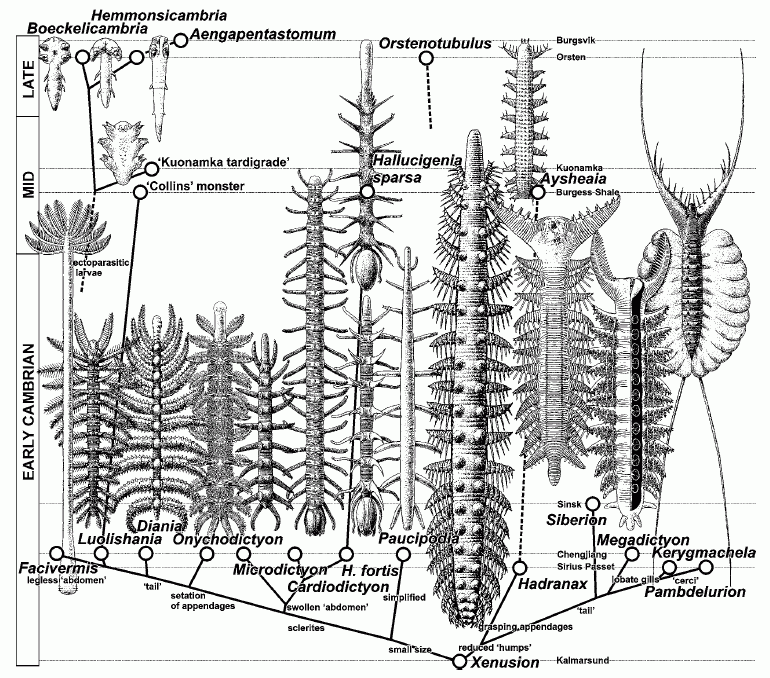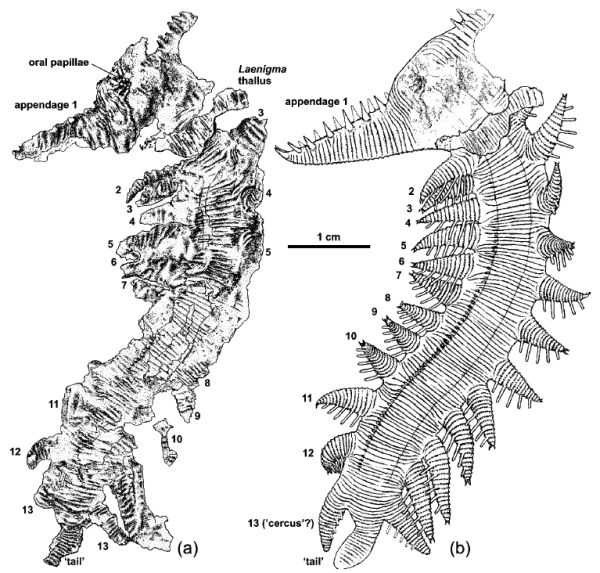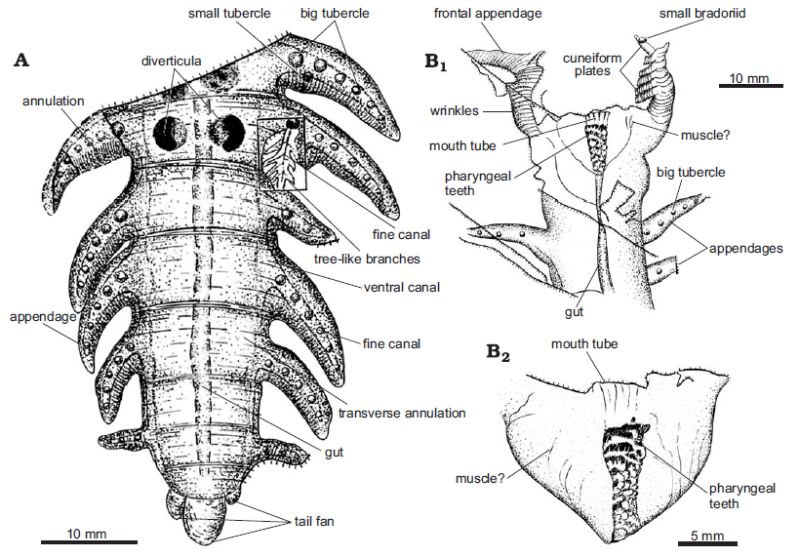|
|
Panarthropoda |
| Ecdysozoa |
Siberiidae |
Ecdysozoa: Panarthropoda: Siberiidae
Taxa on This Page
- Siberion X
- Jianshanopodia X
- Megadictyon X

Not a forest of Christmas trees, but a selection of Cambrian lobopodians (paraphyletic class Xenusia), from Dzik 2011 fig 3. Compare this stylised mode of illustration ( a bit like Greg Paul's dinosaur silouhettes) with Monge-Nájera & Hou's "photorealistic" illustrations of many of the same taxa. Dzik's stratigraphic-evolutionary phylogeny is based strongly on the presence or absense of large grasping appendages, which results in two main evolutionary lines, lobopodian and proto-arthropod. Siberion and Megadictyon, decsribed on this page, are on the right of the diagram, and one can see the obvious similarity (at least in these reconstructions) with Kerygmachela. Xenusion here becomes a "metataxon" at the base of the panarthrpod tree, both because of its generalised morphology and its early stratigraphic record. This phylogeny differs from many of the cladograms shown earlier, although the division into lobopodians (shown on the left) and protoarthropods and arthropods (shown on the right) is in keeping with Liu et al 2011, and even with Ma et al 2009's "Archonychophora" clade |
Paleontological research over the last six years has recovered several extraordinary Early Cambrian lobopodians, specifically Jianshanopodia and Megadictyon from the Chengjiang Fauna of China, and Siberion from the Lena River of Siberia. Their compelling status as candidates for stem-group arthropods (we have used the informal term "protoarthropod" to rever to this grade) derives from characters shared with anomalocaridids or proto-anomalocaridids. These include generally large size, robust, annulated frontal grasping appendages with a row of strong spines along the inner margin, and segmentally repeated midgut glands (caecae-like structures). (Edgecombe 2009, Dzik 2011)
The same kind of segmentally repeated midgut glands is also found in both advanced arthropods, primitive true arthropods such as Leanchoilia, and protoarthropods such as Kerygmachela and Pambdelurion, as well as Jianshanopodia, Megadicyton, and Siberion. The detailed structure of these glands, consisting of an internal structure of lamellae on a submillimetric scale, illustrates the arthropod affinities of these advanced lobopodians (Edgecombe 2009).
Although the grasping arms of Jianshanopodia, Megadictyon, and Siberion differ from the anomalocaridid frontal appendages that first appear in Kerygmachela and Pambdelurion, in that the latter are more sclerotized (stiffened) and arthropodized, (having pivot joints and membrane between the stiffened regions), their equivalent position and general structural similarity strongly support their homologous nature (i.e. they are the same type of structure, with the same evolutionary origin, although found in different species)
There is however some variation among these early forms in that Jianshanopodia has complex branched appendages and a sucking pharyngeal mechanism, whereas Megadictyon possesses anomalocaridid-like 'Peytoia' or pineapple-ring-shaped slicing mouthparts (Liu et al 2008 p.280), and a ventrally (downward-facing) positioned mouth. The ventral mouth is an advanced feature that is shared with arthropods and, although already acquired in the basal proto-arthropod Pambdelurion is absent in the very similar and contemporary Kerygmachela. Here, as with the arthropodised but otherwise unexceptional lobopodian Diania we have another instance of mosaic evolution among parallel and related but distinct evolutionary lines, with the more primitive Megadictyon being more advanced in this regard than the ortherwise more specialised Kerygmachela. (Edgecombe 2009)
In this way, both prey capture (grasping arms), oral processing (pineapple ring mouthparts) and digetsion (specialised gut morphology) are advanced over the earky lobopodian condition, and would clearly have provided a great adptive advantage to these precursors of the arthropods. Yet by the Atdabanian and Botomian ages, these innovative panarthropods had already been morphologically surpassed by their euarthropod descendents. Proto-lobopodians (Mureropodia), several grades of lobopodians (Aysheaia, Xenusiids, Hallucigenia, Luolishaniids, Diania, etc), Siberiids, both basal (Kerygmachela) and advanced (Opabinia, Anomalocaris) dinocaridids, stem arthropods, great appendage arthropods, early trilobites, and proto-chelicerates and proto-crustaceans all co-existed in a highly diverse ecological setting, in which panarthropods were represented by a great-chain-of-being-like unbroken continuum from unarmoureed and armoured scalidophoran worm through a great morphological and evolutionary diversity of lobopodians to an even greater diversity of arthropods. It was a world very different from our own, but just as rich and unique MAK120501
Descriptions

Siberion lenaicus A Camera lucida drawing of the holotype ZPAL V37/1. B. Interpretation of the holotype specimen with tentative restoration of appendages. Illustration and caption from Dzik 2011 fig 2. |
Siberion lenaicus Dzik 2011
Horizon: Sinsk Formation of Lena River, Siberia, Botomian, Bergereniellus gurarii or early B. asiaticus trilobite Zone. Early Cambrian,
Phylogeny: Panarthropoda : Aysheaia + (Tardigrada + (various lobopodia + Onychophora + (more lobopodia + (Jianshanopodia + (Megadictyon + paraphyletic Dinocaridida + (Schinderhannes + Arthropoda)) + * ))))
'Tail' with annulation, a row of minute tubercles on sides of the body with about 9 annuli per appendage pair; all 12 postoral appendage pairs of similar size and shape bear probably tubular extensions, serially emerging from annuli; the cylindrical gut probably lacks caeca. ILike Jianshanopodia, and Megadictyon, Siberion is a large lobopodian with These ae a prominent grasping first pair of appendages, reduced proboscis in relation to Aysheaia, tail-like terminal extension of the body; and appendages with weakly sclerotised serial gill-like structures extending dorsally from some annuli.
Comments: Dzik 2011 coined the monotypal Order Siberiida and family Siberiidae for the three genera Siberion, Jianshanopodia, and Megadictyon. This is a paraphyletic or evolutionary grade, of transitional forms intermediate between lobopodians and protoarthropods, not a monophyletic clade. The large grasping appendages are very similar to those of the anomalocaridids and indicate predatory habits. Unlike the anomalocaridids there are no flaps or arthropodial appendages. So far, Siberion has not been ranked cladistically. As Jianshanopodia and Megadictyon have been variously considered lobopodians (Ma et al 2010) and protoarthropods (Liu et al 2011), Siberion can be placed there as well. This specimen is rather smaller than its Chengjiang equivalents, about 5 1/2 rather than 20 cm in length. MAK120501
On a depressing note, Dzik reports that there is little chance of additional specimens being found at this fossil locality as it was recently destroyed by commercial fossil collectors (Dzik 2011). While we support responsible fossil collecting, it is essential for science that those rare and special regions where important fossils occur are safeguarded from abuse and destruction
Reference: Dzik 2011
Jianshanopodia decora Liu et al., 2006
Horizon: Helinpu (Chiungchussu) Formation, Yu'an-shan Member (Eoredlichia Zone), Chengjiang Lagerstätte, Yunnan, South China, (Atdabanian age - Early Cambrian)
Phylogeny: Panarthropoda : Aysheaia + (Tardigrada + (various lobopodia + Onychophora + (more lobopodia + (Siberion + (Megadictyon + paraphyletic Dinocaridida + (Schinderhannes + Arthropoda)) + * ))))
Characters body length (excluding appendages) ~22cm, centrally situated mouth; pair of strong frontal appendages equipped with a series of cuneiform plates. trunk region with at least nine segments, each bearing a pair of complex appendages with two rows of tubercles on their dorsal side, with tree-like or lamellate branches protruding from the tubercles. Three small lobes seem to be arranged into a tail fan . (Liu et al 2006b).

Janshanopodia decora, camera lucida drawings, showing morphology evident from the Chengjiang fossils. A. A sketch drawing of the specimen ELI-J0005A, demonstrating all available features. B. specimen ELI-J0001. B1, the anterior part of Jianshanopodia , showing the strongly wrinkled frontal appendages, mouth tube and funnel-like pharynx structures; B2, enlargement of the funnel-like pharynx structures of the same specimen. Illustration and caption from Liu et al 2006b fig.2. |
Comments: As a rare truly transitional form, Jianshanopodia combines characteristics both of primitive xenusian lobopodians such as Aysheaia and Xenusion with the most primitive protoarthropods like Kerygmachela and Pambdelurion. Liu et al 2006b placed it in the family Xenusiidae, and more recently Dzik (2011) transferred it to his new ordinal rank taxon Siberiida. But the features Jianshanopodia shares with Xenusion - large cylindrical body with annulations and stout and strong lobopods each bearing bases of serial tubercles - would simply be primitive (plesiomorphic) for large lobopodians as a whole, and most cladograms are unanimous in placing it above a paraphyletic lobopodia. The features shared with protoarthropods are more evolutionarily significant. Jianshanopodia is the most basal taxon to show specialization and differentiation of limbs, such as frontal appendages or trunk limbs. (Liu et al 2011 fig. S1). It shares with Early Cambrian protoarthropodsPambdelurion and Kerygmachela pairs of mid-gut diverticula, a tail fan, a mouth cone, frontal pharyngeal structures and a pharynax are surrounded by the bases of large grasping frontal appendages. But unlike the segmentally arranged, paddle-like, movable side flaps of Pambdelurion and Kerygmachela, Jianshanopodia possesses distinct complex appendages with tree-like or lamellate branches, and may throw new light on the origin of biramous limbs. (Liu et al 2006b) In other respects though, Jianshanopodia seems to be too primitive to serve as a biramous arthropod ancestor, and as with the arthropodisation of Diania may serve as a "prophetic" form, and an example of mosaic evolution. there is also an ecomorphic distinction, in that the presence pof strong complex limbs imples a walking or crawling rather than a swimming lifestyle. In any case. with its fascinating combination of primitive and advanced characteristics, Jianshanopodia represents a non-missing link between loboipods and arthropods, just as loboipods are a link between worms and arthropods. MAK120501
Megadictyon haikouensis Luo & Hu, 1999
Horizon: Chengjiang Lagerstätte, Yunnan, South China, (Atdabanian age - Early Cambrian)
Phylogeny: Panarthropoda : Aysheaia + (Tardigrada + (various lobopodia + Onychophora + (more lobopodia + (Siberion + Jianshanopodia + (paraphyletic Dinocaridida + (Schinderhannes + Arthropoda) + * )))))
Characters: Megadictyon alone: Heteronomous annulation (Daley et al 2009 cladogram, supplement fig S3). In common with more derived taxa: paired, segmentally arranged midgut glands; - Megadictyon Edgecombe 2009) fig 3; Circumoral structure plate-like with teeth at inner margins of plates. (Daley et al 2009 cladogram, supplement fig S3); Lobe-like trunk limbs without spines or tubercles Liuetal2011 fig. S1, ventrally positioned mouth (Edgecombe 2009)
Comments: Megadictyon cf. haikouensis had a head bearing caecae-like structures resembling those of the proto-trilobite Naraoia and some chelicerates, and possesses anomalocaridid-like 'Peytoia' mouthparts and grasping frontal appendages. These latter two features are shared with the AOPK (Anomalocaris-Opabinia-Pambdelurion-Kerygmachela) grade of protoarthropods (ref Cambrian lobopods) showing the advanced and transitional nature of this taxon. MAK120501


